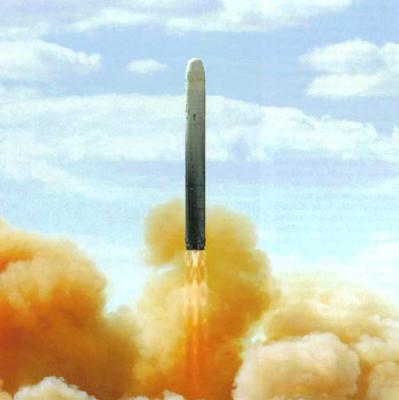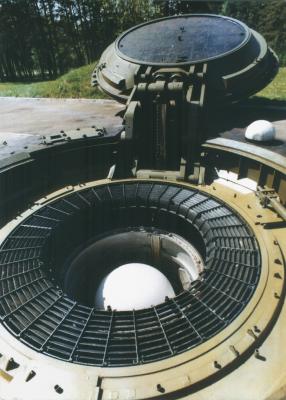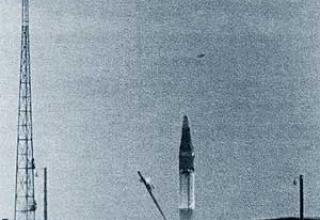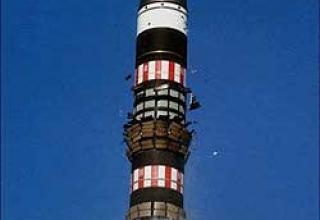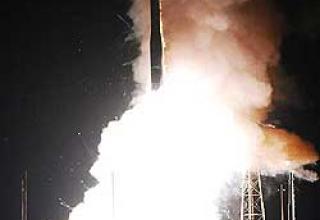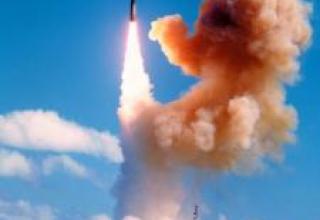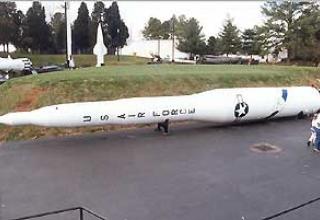The third generation intercontinental liquid-propellant ballistic missile 15A30 (UR-100N) with split head part of individual guidance (RSH IN) was developed at the Central Design Bureau of Mechanical Engineering under the leadership of V.N. Chelomey. In August 1969, a meeting of the USSR Defense Council chaired by Leonid Brezhnev was held, where the prospects for the development of the USSR Strategic Missile Forces were discussed and Yuzhnoye's proposals regarding the modernization of the R-36M and UR-100 missile systems already in service were approved. At the same time, the scheme proposed by the Central Design Bureau to modernize the UR-100 missile system was not rejected, and in fact, the creation of a new UR-100N missile system was not rejected. On August 19, 1970, Government Resolution No. 682-218 was issued on the development of the UR-100N (15A30) missile system with the "heaviest missile from lightweight ICBMs". (this term was later adopted in agreed treaties). Along with the UR-100N complex, a complex with MR-UR-100 ICBMs (led by M.K. Yangel) was created on a competitive basis. The UR-100N and MR-UR-100 complexes were proposed to replace the lightweight UR-100 (8K84) family of ICBMs adopted by the Strategic Missile Forces in 1967 and deployed in mass numbers (deployment peaked in 1974 when the number of simultaneously deployed ICBMs of this type reached 1,030). The final choice between the UR-100N and UR-100 ICBMs had to be made after comparative flight tests. This decision initiated what is referred to in historical and memoir literature on Soviet space rocket technology as the "dispute of the century". According to its TTH, the UR-100N complex, with a very perfect rocket in terms of basic technical characteristics, was between the "light" MR-UR-100 and the "heavy" R-36M, which, according to a number of participants and observers of the "dispute of the century", gave rise to the hopes of VN Chelomey not only that his rocket will be able to win the competition with the MR-UR-100, but also that it, as a cheaper and more mass-produced, will prefer a relatively expensive heavy R-36M. Such views, of course, were not shared by M.K. Yangel. In addition, the country's leadership also considered it absolutely necessary for the USSR's defense to have heavy class ICBMs as part of the Strategic Missile Forces, so Chelomei's hopes for the "replacement" of the R-36M by the UR-100N did not come true.
For V.N. Chelomey the difficulty of creating a new missile was that the refinement of the mine launcher complex under the UR-100N missile with its "hot" "gas-dynamic start" almost resulted in a complete dismantling of the existing SHU and the construction of a new one with a full cycle of construction work (to harden the shaft of the mine needed a complete dismantling of the shaft, its headband and a powerful foundation, excavation works to increase the diameter of the mine and the construction of a new reinforced concrete frame structure), etc. Otherwise, there would be a real danger of a supersonic gas flow and seals jumps in some places of the gas flow control system with sharp changes in its modes (pressure, temperature, heat exchange), leading to an emergency launch of a new promising missile. Roughly speaking, only the axis line remained unchanged from the previous SHU, while the new and risky concept of "cold" mortar launch proposed by M.K. Yangel for both missiles developed by his team allowed to actually manage the already built SHUs with the necessary modifications (it looked like a more rational use of already built SHUs, i.e., a more economical approach). When designing the mine structure of the new missile complex UR-100N, the TsNIImash was assigned to develop the start gas dynamics. The Institute coped with this task with a small model. It was used to carry out experiments with precision and test small-size gas-discharge vehicles. To reduce the unacceptably high levels of shock-wave pressure on the rocket UR-100N at the launch of its engine in the lower part of the container on the recommendation of the Institute was installed specially designed dural screen. When the missile was raised, the screen under the influence of jets was destroyed, which further ensured the ejection mode of the current. At the same time, despite the large amount of work required, according to the U.S. intelligence, the OS 15P730 SLBM (then 15P730P, 15P735) held the first place in terms of resistance to PFBI among other Soviet silo missile systems until the adoption of the Voevod R-36M2 ICBM (15A18M, OS 15P718M SLBM) and RT-23UTTH "Molodets" (15J60, OS 15P760 SLBM). At the same time, the leader was the last complex. In the 1980s American experts estimated the probability of destruction of the OS 15A35 complex UAI by two hits of the Mk12A with the W78 BC (Minuteman-III ICBM) of 335 kt each as 0. 509, while two Mk12As with a W62 (Minuteman-III ICBM) of 170 kt each destroyed the same mine with a probability of 0.333, and two Mk4s with a W76 (Trident I C4 SLBM) of 100 kt each could not destroy this SSB at all (probability 0). For the SPM of 15A18 complex the American analysts' estimates gave the following probability figures: 0.590 (Mk12A), 0.407 (Mk12) and 0.044 (Mk4). Translated with www.DeepL.com/Translator (free version)
The 15A30 ICBM flight and design trials were conducted at the Baikonur range (Lieutenant General E.B. Volkov, Chairman of the State Commission). The first launch of the 15A30 ICBM took place on April 9, 1973. The tests were conducted under a reduced program, as the developers presented calculations that justified this approach. This made it possible to complete the tests in October 1975, when the last of 27 launches was made. During the tests, launches were made with monoblock HF, as well as RPHNs with 4 and 6 combat units. The first regiment with BRK 15P030 was on combat duty in the 46th Nizhnedniprovsk Red Banner Order of the October Revolution Missile Division (Pervomaysk, Nikolaev region, the Ukrainian SSR) on April 26, 1975. On December 30, 1975 by the Government Resolution No. 1063-356 the missile system UR-100N (15A30) was adopted for service. The first regiment with UR-100N missiles, equipped with 15P030P MRBMs of enhanced resistance to PFIA, went on combat duty in the 60th Taman Red Banner Order of the October Revolution Missile Division named after the 60th Anniversary of the USSR (Tatishchevo, Saratov region, RSFSR) on December 18, 1976. Later all the existing missile divisions were brought to the level of 15P030P. A group of military and civilian specialists, including Defense Minister A.A.Grechko, received the Lenin Prize for the creation of a reinforced SLBM for the UR-100N missile system. The "dispute of the century" itself ended quite unexpectedly - both UR-100N and MR-UR-100 were adopted for service, although the latter is much smaller in number than the first one (finally - 360 vs. 150). The work on the UR-100N complex as a whole turned out to be more complex and expensive (as compared to the MR-UR-100 missile system), but it fully met the prospects of missile weapons development. Besides, it seems that the country's leadership was afraid of the possibility of concentrating the development of liquid-propellant ICBMs of all classes in "one hands" (Yuzhnoye SDO).
Mass production of 15A30/15A35 ICBMs was launched in 1974 at the Khrunichev Moscow Machine Building Plant. Production of the first stage marching engines was mastered by the Voronezh Mechanical Plant and a branch of the Perm Engine Building Plant named after Yakovlev Sverdlov. Second stage marshalling engines and steering engines were produced by the Leningrad Machine-Building Production Association "Krasny Oktyabr". The engines of the breeding block were produced by the Ust-Katavskiy Carriage Works. The control system components were assembled at the Kyiv Radio Plant, the Taras Shevchenko Plant and the Kharkiv NPO Khartron. The warhead deployment unit and control system were manufactured at the Orenburg Arrow Production Association.
However, the developers' "pioneering" decision to reduce the test programme had negative consequences. When launching missiles under the program of combat training with shooting at the maximum range in the second half of the 70's there was a serious incident with the missile system UR-100N. When UR-100N missile, which was on combat duty, was launched to the maximum range in order to check the condition of the complexes, the results were unexpected. Deviations of the drop points of the combat units from the aiming points were much higher than the calculated ones. The launch was repeated and the results were the same. It became clear that the missile design hides some defect that was not detected during the tests. But there were already dozens of missiles on combat duty, and the delivery of new missiles was being prepared at an accelerated pace. The study of the reasons for inadmissible deviations in the drop points of the blocks made it possible to establish the following. At the last seconds of operation of the 1st stage WRD began intensive longitudinal vibrations of the missile, which caused resonance vibrations of the range control system elements. As a result of these vibrations onboard instruments that measured the flight distance, gave the wrong command to turn off the engines, which led to unacceptable deviations of the drop points of the blocks. In the development of measures to eliminate fluctuations in the rocket UR-100N were involved the most experienced missile organizations - Design Bureau, research institutes, training grounds, etc. A special decision was taken to allocate additional missiles for flight tests. The head organization was determined by the Central Design Bureau of Mechanical Engineering, conducting flight tests was entrusted to the same State Commission that conducted tests of the UR-100N ICBM. The period of improvement of these missiles began. The work was organized as follows. The Council of Chief Designers at the Central Design Bureau of Mechanical Engineering, chaired by VN Chelomey, developed proposals for the revision of the missile. Relevant changes were made at the plant producing missiles named after V.N. Chelomey. Khrunichev. The modified missile was sent to the Baikonur range, where it was launched under the program providing for complete burnout of the first stage fuel. The data obtained from the launches made it possible to assess the efficiency of the refinement. Thus, there were several launches of rockets with different variants of refinement. The results were negative - fluctuations could not be eliminated. Meanwhile, the terms and stocks of missiles released for modification were expiring. The situation was becoming threatening. An alternative solution to the problem was found in a completely different place than where it was sought. General Designer V.N. Chelomey insisted on modifying the SU equipment to avoid resonance modes and replacing it on all missiles. However, M.S.Natanzon, researcher at NIIMP, suggested a simpler solution: in the tail compartment of the 1st stage of the rocket to put antivibrators (dynamic vibration dampers), tuned to a dangerous frequency and suppress it in the spectrum of vibrations of the rocket. Manufacturing and installation of such antivibrators were quite simple and cheap operations. TsNIImash under the leadership of Yu.A. Mozzhorin conducted an extensive set of theoretical and experimental studies. The role in solving this problem was played by the bench dynamic tests of a natural rocket with installed vibration dampers. In a short time, the necessary calculations were carried out, vibration dampers were produced and installed on the rocket, which is being prepared for shipment to Baikonur. The results were known as soon as the first stage engines were finished - flight data were transmitted to the ground by the telemetry system. There were no unacceptable fluctuations. Missile launches with vibration dampers were repeated immediately. The results were the same. However, there were missiles without vibration dampers on duty in the mines. Under extremely difficult conditions - at a depth of about 20 m - dampers were installed. Later on, control launches of the missiles were conducted dozens of times. The high reliability of the complexes was confirmed. However, additional efforts and considerable financial resources had to be expended in order to eliminate the shortcomings.
On August 16, 1976, the Government Decision No. 654-214 on improvement of the tactical and technical characteristics (TTTH) of the UR-100N missile system was issued. The modernization of the missile complex was carried out in the following main directions: increasing resistance to fossil fuels and improving the combat efficiency of the complex. The new missile differed from its predecessor by a new stage of dilution (more resistant to fossil fuels, which allowed to increase the range of firing, to improve the construction of orders of magnitude from the elements of combat equipment, to increase the area of the AB dilution area), improved control system (more resistant to fossil fuels, which provided increased accuracy of firing), which allowed to choose one of 6 targets, Advanced missile defense systems for boost-phase missiles, which significantly expanded the use of MRBMs), improved missile defense SSBs, new boost-phase interceptors (more high-speed, high-performance, high-precision, and PFC-resistant), enhanced PFC resistance for the OS 15P735 SLBMs and the 15P035 MRBMs as a whole (later all the existing 15P030P MRBMs were upgraded to the 15P035 level with the ability to withstand pressure in a shock wave up to 100 atmospheres). On the whole, the operation of the missile systems has been considerably simplified, with a simultaneous increase in their resistance to nuclear blast threats. All this has been achieved without altering the mass of ICBMs and the mass to be launched. On October 26, 1977, the flight development tests of the 15A35 missile with improved TTX (UR-100N UTTX) began at Baikonur. This time they were conducted in full. A total of 68 test launches of the improved missile in the period from September 28, 1977 to July 26, 1979. All launches during the LKI were conducted: on the area "Kura", on the area "Water area". (at maximum range), the area of "Kzyl-Tu" (at minimum range of about 1000 km). On 17 December 1980, by Government Resolution No. 1180-402, the UR-100N UTTH missile system was adopted for service. The first regiment with the new missile system was the 19th Zaporozhye Red Banner Order of Suvorov and Kutuzov Missile Division (Khmelnitsky, Khmelnitsky region, Ukraine), which became fully operational in January 1981. By 1984, a total of 360 UR-100N UTTH missiles had been deployed in 4 position areas of the country (except for the 3 abovementioned areas - also the 28th Guards Red Banner Missile Division, Kozelsk, Kaluga Oblast, RSFSR). Production of missiles was discontinued in 1985. After the deployment of improved missiles to make the most of the capabilities of the complex with 15A35 ICBMs at the end of the first and beginning of the second half of the 80s in all operating units to improve the stability of the combat control system were formed mobile spare command posts (PKP) "Vibor" on MAZ chassis of high cross-country ability. Computer centers were formed in the divisions to ensure prompt calculation of flight tasks.
The 15A30 ICBMs were initially deployed in high-security ICBMs developed by Branch No.2 of the Central Machine Building Design Bureau (now the State Research Institute "Vympel Design Bureau") headed by V.M.Baryshev. Later all existing high-security mines were converted into high-security mines. Totally 360 high-security shaft starting units (HSS) were built. They were located in the position areas of the divisions located under the towns of Pervomaysk (90 HS), Khmelnitsky (90 HS), Tatishchevo (110 HS) and Kozelsk (70 HS). A total of 360 ICBMs of this type were deployed. Beginning in 1988, solid-propellant 15G60 ICBMs began to be deployed in formations located beneath the cities of Pervomaysk and Tatishchevo instead of 15A35 ICBMs that were taken off duty. By the end of 1989, 56 new missiles had been placed on combat duty, and 60 15A35 ICBMs had been decommissioned instead. However, starting from 1990, this process was halted until the collapse of the USSR at the end of 1991. A part of still deployed 15A35 missiles (130 units) after the collapse of the USSR found themselves on the territory of Ukraine and was later eliminated in accordance with the letter of international treaties. However, 31 sets of 15C300 missiles (15A35 ICBMs in the ICBMs without the HC and SU) were not destroyed. Russia bought from Ukraine in 2002-2004. Russia purchased 30 such kits from Ukraine in 2002-2004, which were stored in undelivered condition. According to Solovtsov, then Commander-in-Chief of the Russian Strategic Missile Forces, these missiles could remain on active duty at least until 2020 and at most until 2030.
According to official data, as of July 2009. Russian Strategic Missile Forces had 70 deployed ICBMs 15A35: 1. The 60th Rocket Division (Tatishchevo), 41 UR-100N UTTX 2. 28th Guards Rocket Division (Kozelsk), 29 UR-100N UTTKh.
The last division was previously in the process of liquidation, however, by the decision of Russian President Dmitry Medvedev in November 2008 the liquidation process was terminated. The division will continue to be on duty from the 15A35 ICBMs until they are re-equipped for "new missile systems" (most probably, either Topol-M or RS-24). It is likely that in the near future the number of 15A35 missiles on combat duty will continue to decline until they stabilize at around 20-30, taking into account purchased missiles. For comparison with July 2009 (when the number of 70 ICBMs was included), as of January of the same year 97 missiles of this type were deployed and 110 missiles in January 2008.
The UR-100N UTTH rocket complex is extremely reliable - 165 test and combat training launches were conducted, only three of which were unsuccessful. The American magazine of the Air Force Rocket Association called the UR-100N UTTH rocket "one of the most outstanding technical developments of the Cold War". The first complex, still with UR-100N missiles, was put on combat duty in 1975 with a 10-year warranty period. During its creation, all the best design solutions tested on previous generations of "sotok" (8K84/UR-100,8K84M/UR-100M,15A20/UR-100K,15A20U/UR-100U) were implemented. The high reliability indices of the missile and the complex as a whole achieved later during the operation of the improved complex with the UR-100N UTTX ICBMs allowed the country's military and political leadership to set a task for the Ministry of Defense, the General Staff, the Strategic Missile Troops Command and the leading developer in the person of NPO Mashinostroyenie to gradually extend the operational life of the complex from 10 to 15, then to 20, 25, and finally to 30 years and beyond. In the 1990s, after the collapse of the USSR, the country's military and political leadership made a decision to begin work to significantly extend the service life of the RK with the UR-100N UTTX ICBMs instead of definitively removing them from service and replacing them with the RT-23 UTTX "Molodets" ICBM complex, as originally planned in the second half of the 1980s. This task, with an acute shortage of budget funds allocated for the maintenance of existing and the purchase of new strategic and other weapons, was identified by the country's military and political leadership as a special priority. In these conditions, the role of long-term cooperation between the engineering NGOs and the Strategic Missile Forces increased significantly. Since 1996, the Machine-Building NPO, as the parent enterprise in joint cooperation with other enterprises, has been solving the most important task - to work on extending the service life of the missile system with UR-100N UTTKh ICBMs under combat duty (topic "Zaradye"). In order to carry out these activities, the Council of General (Chief) Designers was established in 2000 on the initiative of the Machine-Building NGO, whose task is to coordinate all cooperation between the enterprises that develop (manufacture) components of the complex and services of the Strategic Missile Forces. Every two years, the Council carries out its work directly at the objects of operation. Based on the results of the Council's work, the appropriate decision is drawn up, which determines the order of ensuring and prolonging the life of the RK with MBR UR-100N UTTH. The main result of the work in this area is confirmation of the high reliability of the missile systems with UR-100N UTTKh ICBMs on duty for a long time. The task to ensure such a long service life of the complex while maintaining high combat and technical characteristics was solved for the first time in the world. It was necessary to implement a lot of research and development activities combined into one integrated program. Approaches were found to predict the state of the complex for at least 2-3 years in advance. The reserves of strength of power structures are determined, the condition of fuel tank walls is thoroughly checked, the condition of rocket fuel components is analyzed, and accelerated tests are carried out in climatic chambers, providing equivalent effects of environmental parameters on the structures of missile complex units and assemblies. The experience gained is universal and is used to extend the service life of all systems with liquid-propellant missiles.
Regular launches of UR-100N UTTH from Baikonur Cosmodrome are an important stage in the confirmation of the main TTH of the missile. The rocket with the maximum service life is selected for launch. The last launch to date was on October 22, 2008, when UR-100N UTTH rocket was launched from Baikonur. The head unit successfully hit the targets at the Kura test site. The launch confirmed that the main flight and technical characteristics of the RS-18B ICBMs remained unchanged and also demonstrated a high degree of reliability of the system for operating combat missile systems. In December 2008, based on the results of the tests and studies, the decision was made to extend the service life of the missiles to 33 years. Economic calculations show that the preservation of the UR-100N UTTH missiles within the Russian Federation's SNF in the last 10 years alone made it possible to free up several tens of billions of roubles for the solution of important state tasks. It was noted that during the period of operation the UR-100N UTTKh missiles were launched not only at the maximum (10,000 km) but also at the minimum (about 1,000 km) range, which provides flexibility of its use in modern changing geopolitical conditions. A considerable amount of experimental data to extend the life of RS-18B ICBMs is also acquired as part of the program to use Rokot conversion boosters, delivery of the 15C300 block for which (1st and 2nd marching stages of 15A35 ICBMs in the routine 15Ya64 ICBMs) is carried out from the Strategic Missile Forces to the Space Forces after the relevant verification activities. Based on the R&D results, in February 2011 it was announced that the guaranteed life of 15A35 ICBMs could be extended to 36 years.
Over the past decade, the mass media have repeatedly published information of various kinds, containing information on the need for, and even the beginning of work on the creation in Russia by the domestic cooperation of manufacturers of new liquid-propellant ICBMs weighing about 100 tons with RSHI in order to put it into service in the period "after 2015," but no specific instructions to start work in this area for a long time has not been officially announced. Both supporters and opponents of this idea noted that, most likely, the final decision in this direction will be made based on the final results of MIT's work on prospective weapons - ICBMs with RS-24 and SLBMs with RS-30 "Bulava", These results should be finally announced in the next year or two (the location of the RS-24 ICBMs in the troops and on combat duty at this complex was announced in July 2010, and in March 2011 it was announced about putting this complex on combat duty). If this work is successful and the latest mobile solid-propellant ICBMs and SLBMs with RSHI enter service with the Russian Strategic Missile Forces and Navy in sufficient numbers, the need for a promising liquid-propellant ICBM will probably disappear. In addition, the opponents of the new liquid-propellant ICBM, the main advantage of which is the possibility of deploying a significant number of large-capacity ICBMs on a single missile, indicate that under current conditions (the START-3 Treaty, the presence of a number of high-precision weapons in a number of countries, etc.) its main advantage, along with the basing of the ICBM on a SLBM, will also be the main drawback - a large number of combat units can be disabled by striking a relatively small number of stationary carriers in a SLBM. At the same time, in February 2011 it was announced that it is possible to create a promising heavy ICBM with a significant number of combat units on board as a replacement for Voevoda's R-36M2 and UTTKh's UR-100N ICBMs, with their entry into service by 2020. In April 2011, it was officially announced by the representatives of the Strategic Missile Forces that the creation of such a missile, which will have a significantly increased combat survivability due to its constructive perfection, enhanced fortification protection of the OS SLCMs and other passive and active protection measures (including air defense and missile defense facilities of the base area) with the maximum possible use of the already deployed infrastructure of the predecessor missiles. Adoption of the new missile is planned by the end of 2018, in its creation will be adopted and the enterprises of "naval" cooperation, which previously created liquid-propellant SLBMs, led by the GRC named after V. P. Makeev.
In the West, the 15A35 (UR-100N UTTH) missile was designated SS-19 mod.3 Stiletto (under the contract OSV-1 RS-18B), and 15A30 (UR-100N) - SS-19 mod.1,2 Stiletto (under the contract OSV-1 RS-18A).
Composition:
The 15A35 ICBM is a two-stage tandem intercontinental ballistic missile with sequential separation of stages (see the schematic). The missile has a very dense layout and virtually no "dry" compartments.
The body of the first stage (see photo) consists of a tail compartment, fuel compartment and adapter. The fuel tanks are of a supporting structure with a common bottom. The RD-0234 (15D96) first stage propulsion system consists of four RD-0233 (15D95) liquid propellant rocket engines (see photo). Each engine is hinged to the frame in the tail compartment and can deviate from the neutral position in the corresponding plane. The engines have a turbo-pump system of fuel supply with afterburning of generator gas. The upper bottom of the first stage oxidizer tank has a complex shape and consists of a conical part directed inside the tank and a spherical central part having a convexity to the outside. In the space formed thus the nozzle of the marching liquid rod of the second stage takes places. Inflating tanks of marching steps is carried out by means of hot gases. Separation of the first and second steps occurs under the "hot" scheme at the expense of the steering engine of the second step which starts before a command giving on switching-off ZHRD of the first step. The exhaust gases of the second stage steering engine are extracted by means of a special window system in the first stage housing. Then on command there is a rupture of mechanical relations between steps, removal of the first step and start of the marshal engine of the second step. Braking of the first stage is carried out by four solid-fuel brake motors installed in the tail compartment.
The second stage enclosure consists of shortened tail and fuel compartments. Fuel tanks are of a supporting structure. The second stage engine unit includes the RD-0235 (15D113) marshalling LRD, mounted stationary, and the RD-0236 (15D114) four-chamber steering engine (see photo). The marshal engine has a fuel supply scheme with afterburning, and the steering one - without generator gas afterburning. Separation of the third stage from the second one takes place when the LPG is not running due to the traction of the braking solid fuel engines of the second stage. Braking engines of both marching stages are developed in KB-2 of Plant № 81 under the guidance of I.M. Kartukov. To the upper part of the second stage of the rocket case the aggregate-device unit of a separating head part in which inertial control system devices and the breeding engine of military equipment are placed is attached.
Battle units are covered with a fairing. The missile is equipped with a complex to overcome the missile defenses. The UR-100N ICBM nuclear warheads were developed at the Research Institute-1011 (now VNIITF, Snezhinsk, Chelyabinsk Oblast).
The UR-100N was adopted for service with two interchangeable warheads: the "light" monoblock warhead with a thermonuclear warhead with a capacity of 5.3Mt and the RSH IF with 6 uncontrollable boosters, each with a capacity of 400kt (CWO - no more than 650m at the maximum range of 9650km). The nuclear warheads for UR-100N UTTX were developed at KB-11 (nowadays, VNIIEF, Sarov, Nizhny Novgorod Oblast). The UR-100N UTTKh was adopted for service with one variant of multifunctional warheads - RGCH IN with 6 unmanned aerial vehicles, each having a power of 550 kt (CWO - no more than 350 m at the 10,000 km ultimate range). The combat equipment of the UR-100N UTTH allows to hit with confidence high-protected and covered by the ABM system point and area targets. According to Western experts, versions of the equipment of the 15A35 GN IBM RGCH were considered to be new lightweight small-capacity special-purpose ballistic missiles, which would increase the number of ballistic missiles per missile to 18 if necessary.
The RD-0237 dilution engine (see photo) is a liquid engine with a displacement fuel supply system, without generating gas afterburning. The dilution engine as well as the first and second stage marching liquid propellant engines were created in the Design Bureau of Chemical Automatics headed by A.D. Konopatov (Voronezh). All stages use nitrogen tetraoxide and asymmetric dimethylhydrazine as fuel. Development and development of the above mentioned LRDs was carried out in 1969-1974.
The management system was developed in Kharkiv Research Institute-692 (later - NGO "Khartron") under the leadership of V.G. Sergeev. An autonomous inertial control system with 15L579 BCVM is installed on the missile. The onboard computer system is unified with missile 15A18. At carrying out of combat duty all major parameters of a rocket are continuously supervised. High characteristics of the SU were confirmed during launches. The CWO does not exceed 350 m (during the initial operation period for the 15A35 ICBM this value was 430 m). For the control systems of 15A35 and 15A18 ICBMs, for the first time in the USSR, a new technology of software and mathematical testing was developed, including the so-called "electronic launch", at which on a special complex, including BESM-6 computers and manufactured units of the ICBM control system, the ICBM flight and the control system response to the influence of the main disturbing factors were simulated. This technology also provided effective and complete control of flight tasks. The team of "electronic launch" developers (Ya.E.Eisenberg and others) was awarded the State Prize of the Ukrainian SSR. Installation of new control equipment made it possible to fully automate the cycle of inspections of the technical condition of missiles and launcher systems.
The combat launch complex UR-100N UTTH includes 10 missiles in 15P735 SHPU, command post 15B52U and repair and maintenance base. The unified command post of enhanced protection of the mine type was developed in the Central Design Bureau of Mines under the leadership of B.R.Aksyutin. The 15A35 missile has a gas-dynamic launch scheme, at which it leaves the transport and launch container 15Y54, located in the SHPU, on the guides on the inner surface of the TPK due to the thrust force of the propulsion system of the first stage of the missile.
The fuel tanks have been ampouled, and the rocket is in a refueled condition in a transport and launch container for the entire period of operation, which provides the required temperature regime. The design of the TIC allows for maintenance of the rocket systems, filling and discharge of fuel components after the rocket is installed in the mine. The system of maintaining the specified temperature and humidity conditions in the TIC allows at all stages of missile operation to keep it in the required storage conditions. In the silo launcher, the missile's TPK is fixed with a highly effective damping system, providing additional protection of the missile from the effects of nuclear explosion hazards. According to U.S. analysts, the 15A35 ICBM can be launched no more than 3 minutes after the non-porous thermonuclear impact of the OS. The TLC is filled with inert gas-nitrogen. During the combat duty the missile undergoes an intermediate routine inspection once in three months and once in three years. As a result of all the works on improvement of the TTH, the protection of the missile complex facilities has been increased by an order of magnitude. Launch control is remote.
Characteristics:
| Range of fire, km | 10,000 (9,650 with RSH IN) |
| The length of the rocket, m | 24.3 (24.0 for 15A30) |
| Maximum housing diameter, m | 2.5 |
| Start mass, t | 105.6 |
| Weight of the head part, kg | 4350 |
| KVO, km | 0.35 (0.65) |
| Guaranteed shelf life, years | 10 (for 15A35 extended to 33 years) |
| 1st stage remote control - vacuum thrust, kN - thrust at sea level, kN, - specific pulse in a vacuum, s. - specific impulse at sea level, p. - operating time, s. |
2070 1870 310 285 121 |
| 2nd stage remote control - vacuum thrust (marshalling), kN - vacuum specific pulse (marching), s - office hours, s - vacuum thrust (bundled steering), kN - vacuum specific impulse (steering wheel), s - operating time, s |
240 320 183 15.76 293 200 |
Testing:
On the basis of missile 15A35 in the Khrunichev State Research and Production Space Center was created a conversion rocket lightweight class "Rokot" (see photo), its launches are conducted from the State Test Cosmodrome Plesetsk. The Rokot LV is a three-stage rocket. The first and second stages are the UR-100N ICBM missile block. The Breeze upper stage is used as the third stage. The length of the missile - 27.7 meters, diameter - 2.5 meters. The launch weight (without payload) is 107 tonnes. The launch vehicle is capable of launching a payload of 1950 kg into orbit with a height of 200 km or 1250 kg into orbit with a height of 1500 km. Relative weight of the payload is 1.82 %.
On the basis of 15A35 rockets in NPO Mashinostroyenie there is a space rocket system "Arrow" (see photo), designed to launch spacecraft from Svobodny cosmodrome from the upgraded 15P720 silo launcher, designed to launch 15A20 rockets. The main concept implemented in this project is to preserve the maximum continuity of the Arrow Space Station with the base complex. The use of the Arrow Space Missile System will provide economically viable launches of small spacecraft into orbits with different altitudes and inclinations. The 15A20 missile is smaller in size and energy than the 15A35 missile. For this purpose, the 15P720 mine is deepened and reinforced at its lower part. The geometry of the upper part of the SHPU is changed as well, similar to the upper part of the 15P735 SHPU for installation of the gas exhausting grating.
Sources:
- Продление сроков эксплуатации МБР УР-100Н УТТХ /НПО Машиностроения /
- Журнал "Техника и вооружение" 5/6 2001 год
- Вычислительная техника для ракет и космических систем
- Межконтинентальная баллистическая ракета УР-100НУ
- Ю.А.Мозжорин "Так это было..." ("Спор века”)
- Л.В.Каменский, А.С.Намятов, В.А.Хотулев "Проблемы обеспечения газодинамических, акустических и тепловых процессов при старте ракеты-носителя 'Стрела' из шахтной пусковой установки
- М.Первов. "Межконтинентальные баллистические ракеты СССР и России". Краткий исторический очерк. / М.: 1998.
- Андрюшин И.А., Чернышев А.К., Юдин Ю.А. "Укрощение ядра. Страницы истории ядерного оружия и ядерной инфраструктуры СССР" / С., С.: Красный Октябрь, 2003
- "Призваны временем. Ракеты и космические аппараты конструкторского бюро "Южное"./ Под общей редакцией С.Н.Конюхова /. Д.: Арт-Пресс, 2004.
- M.G. McKinzie, T.B. Cochran, R.S. Norris and W.M. Arkin. “The U.S. Nuclear War Plan: A Time For Change” / Natural Resources Defense Council, 2001.
- http://www.npomash.ru
- http://www.khrunichev.ru
- http://www.kbkha.ru
- http://www.okb-vympel.ru
- http://www.vniief.ru
- http://www.astronautix.com
- http://www.globalsecurity.org
- http://www.russianforces.org
- http://www.fas.org
